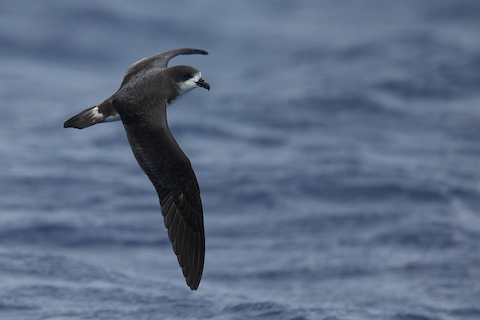Birdfinding.info ⇒ After more than three centuries of presumed extinction, the Bermuda Petrel (a.k.a. Cahow) became one of the great success stories of conservation biology, but it is still very rare. The only place where it can be seen reliably is around its nesting islets at the eastern end of Bermuda, especially in November when it returns and pairs make courtship flights and survey the islands. At this time they can sometimes be seen from shore at Cooper’s Island Nature Preserve, and more readily by boat in nearby waters. Otherwise, it is rarely but regularly seen on pelagic trips from Hatteras, North Carolina—most consistently in late May, and less often through the summer until October.
Bermuda Petrel
Pterodroma cahow
Breeds in Bermuda and wanders the North Atlantic.
Presumed extinct from the 1620s to 1951, when a tiny population was rediscovered. Through intensive conservation efforts (mainly the work of Dr. David Wingate), the population increased from 13 pairs to well over 100 pairs by the mid-2010s.
Breeds from November to June on Nonsuch Island and five adjacent islets at the eastern end of the Bermuda archipelago.
At-sea range is not fully understood, but apparently the most northerly of the Atlantic Pterodromas. It appears to comprise the offshore waters of the North Atlantic around Bermuda and northward. It is known to range west to North Carolina, north to Newfoundland, and east to the Azores—also at least occasionally east to Irish waters.
Identification
A mid-sized gadfly petrel with mostly gray upperparts, white underparts, and boldly patterned black-and-white underwings.
Its most distinctive features are a dark partial hood, or cowl, a white forehead and throat, a narrow white rump band, and a broad black carpal bar on the underwing.
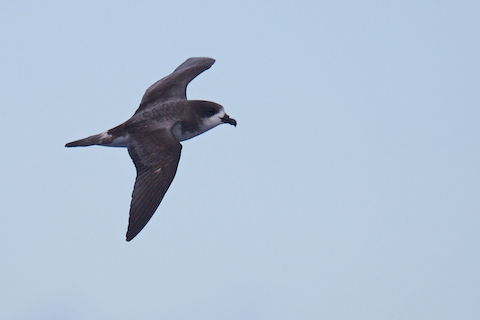
Bermuda Petrel, showing mostly dark-gray upperparts. (Offshore from Bermuda; November 8, 2013.) © Robert Tizard
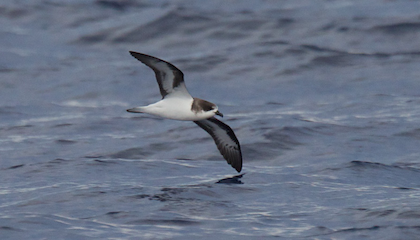
Bermuda Petrel, showing typical gray cowl on neck and bold black carpal bars on underwings. (Offshore from Bermuda; November 10, 2013.) © Robert Tizard
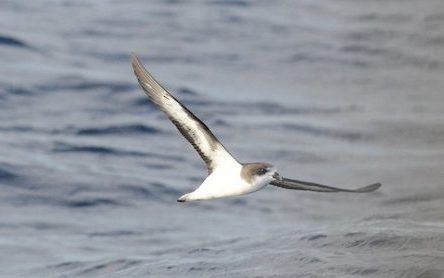
Bermuda Petrel, showing typical gray cowl but appearing pale in this lighting. (Offshore from Bermuda; November 21, 2015.) © Andrew Dobson

Bermuda Petrel, frontal view, showing typical gray cowl on neck and bold black carpal bars on underwings. (Offshore from Bermuda; November 23, 2016.) © Alan Wilkinson
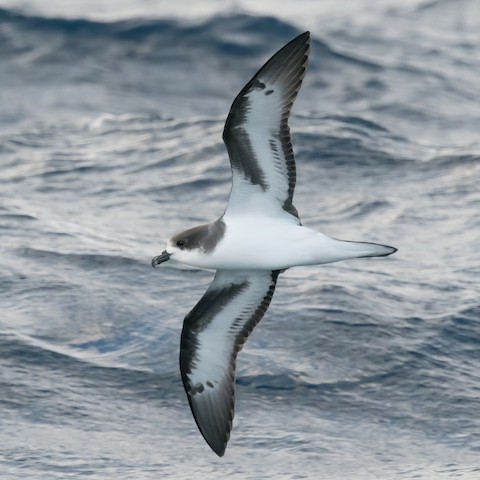
Bermuda Petrel, showing typical gray cowl on neck and bold black carpal bars on underwings. (Offshore from Bermuda; November 22, 2016.) © Alan Wilkinson

Bermuda Petrel, showing mostly dark-gray upperparts and bold black carpal bars on underwings. (Offshore from Bermuda; November 5, 2018.) © Peter Flood
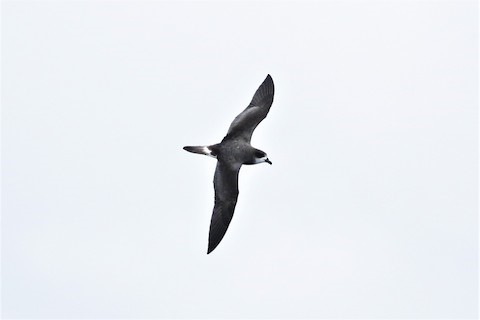
Bermuda Petrel, dorsal view showing typically narrow white rump and subtle “M” pattern on upperparts. (Offshore from Bermuda; November 9, 2018.) © Peter Flood
Upperparts coloration and pattern seem especially variable based on lighting—it can appear almost uniformly dark-gray or mostly pale with a few darker areas: often a dark “M” across the back and wings.
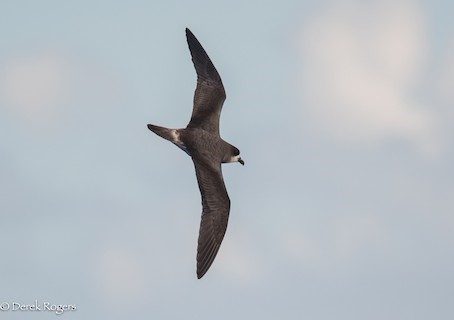
Bermuda Petrel, dorsal view showing typically narrow white rump and subtle “M” pattern on upperparts. (Offshore from Bermuda; November 5, 2018.) © Derek Rogers
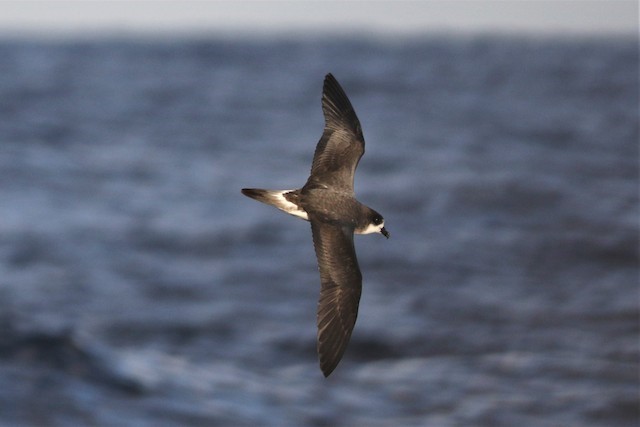
Bermuda Petrel, dorsal view showing typically narrow white rump and subtle “M” pattern on upperparts. (Offshore from Bermuda; November 18, 2017.) © Peter Flood
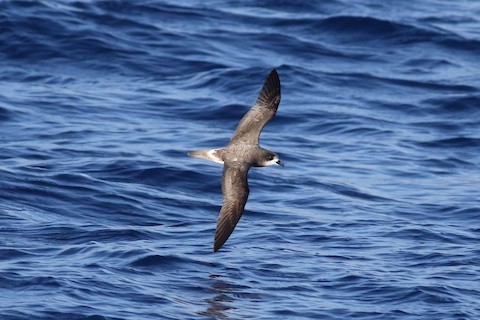
Bermuda Petrel, showing mostly pale-gray upperparts. (Offshore from Bermuda; November 8, 2018.) © Peter Flood
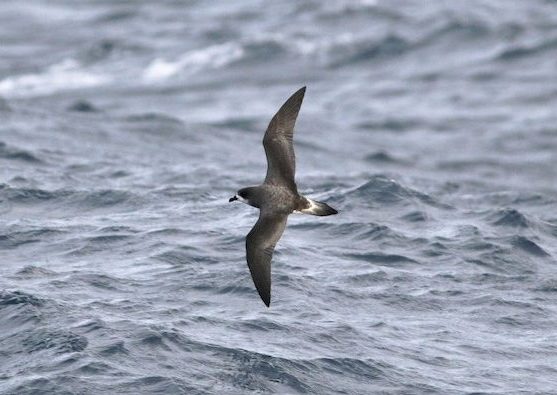
Bermuda Petrel, showing typical coloration and pattern—note dark “M” and white rump band. (Offshore from Bermuda; November 17, 2017.) © Peter Flood

Bermuda Petrel, showing mostly pale-gray upperparts with strong dark “M” and mostly pale-gray tail. (Offshore from Bermuda; November 12, 2013.) © Robert Tizard
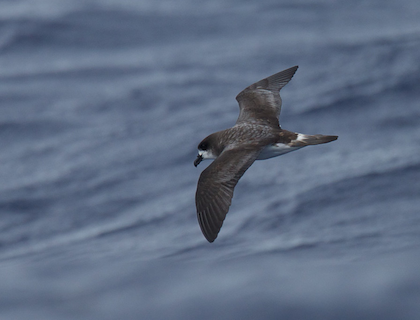
Bermuda Petrel, showing mostly dark-gray upperparts with minimal white on rump. (Offshore from Bermuda; November 8, 2013.) © Robert Tizard
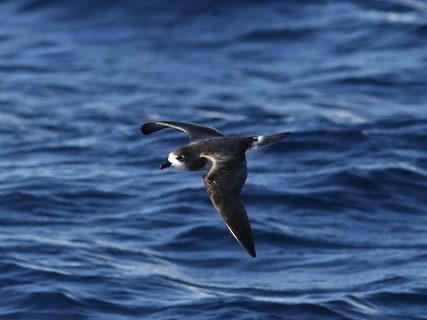
Bermuda Petrel, in bright, low-angle light, emphasizing white face. (Offshore from Bermuda; November 8, 2018.) © Peter Flood
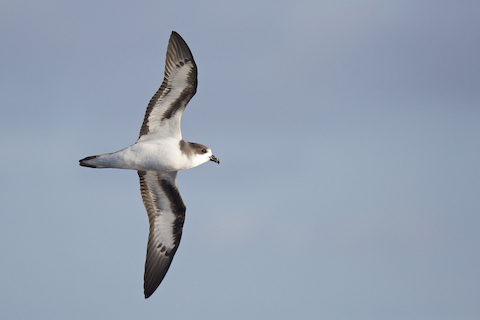
Bermuda Petrel, showing typical bold underwing pattern. (Offshore from Bermuda; November 12, 2013.) © Robert Tizard
The appearance of the underwing pattern is less dependent on lighting. When the wing is fully extended and its underside is clearly visible, it shows a thick, blackish carpal bar on the leading edge and a parallel white stripe of similar width, with a thinner blackish trailing edge.

Bermuda Petrel, with atypical, partially collared appearance. (Offshore from Bermuda; November 23, 2016.) © Peter Flood
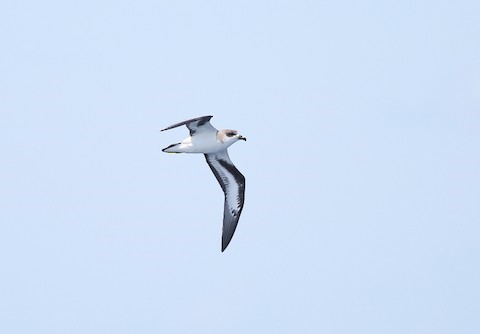
Bermuda Petrel, with head appear pale-gray, but blackish mask around eyes. (Offshore from Cape Hatteras, North Carolina; July 27, 2019.) © Kate Sutherland

Bermuda Petrel, showing typical cowled appearance. (Offshore from Bermuda; November 17, 2017.) © Peter Flood
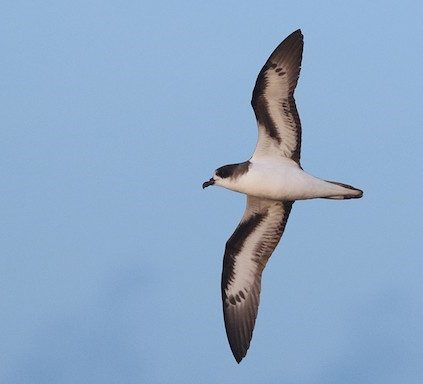
Bermuda Petrel, showing typically bold underwing pattern. (Offshore from Bermuda; November 13, 2015.) © Angus Wilson
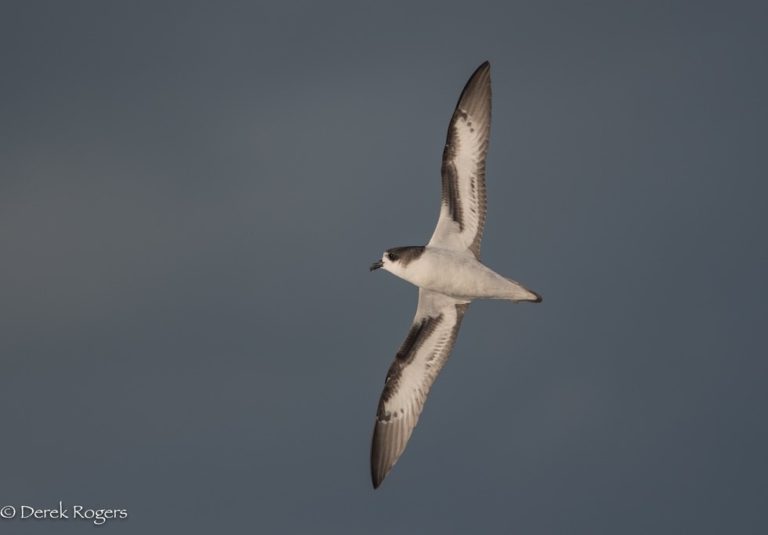
Bermuda Petrel. (Offshore from Bermuda; November 8, 2018.) © Derek Rogers

Bermuda Petrel, showing typical cowled appearance. (Offshore from Bermuda; November 9, 2018.) © Peter Flood
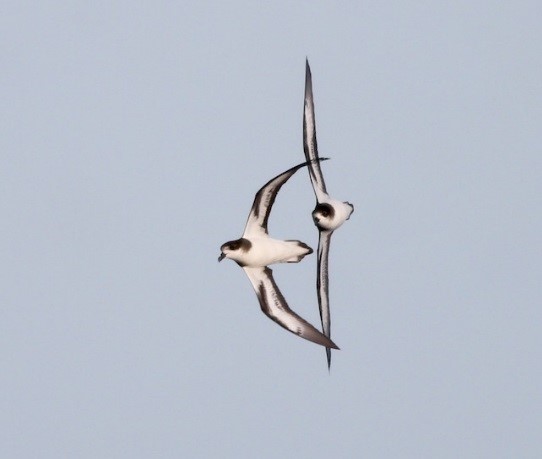
Bermuda Petrel, pair engaged in aerobatic display flight. (Offshore from Bermuda; November 21, 2016.) © Kate Sutherland
Cf. Black-capped Petrel. Black-capped and Bermuda Petrels occur together in the western North Atlantic, mainly in the Gulf Stream and adjacent waters from the vicinity of Cape Hatteras northeast to Georges Bank and east to Bermuda. In the most readily accessible portion of this zone, Black-capped is far more common and Bermuda more sought-after.
Typical representatives of the two species are readily identifiable, but plumage variability in both species complicates the identification of some individuals. The main distinctions are:
Size: Bermuda Petrel is slightly smaller than Black-capped, with a thinner, shorter bill. The bill is useful as an identifying feature mainly when it appears noticeably massive, as that rules out Bermuda Petrel.
Rump-Tail Contrast: The difference that is most conspicuous at long range under normal field conditions is in the prominence of the rump: conspicuously white on Black-capped, narrowly white on Bermuda.
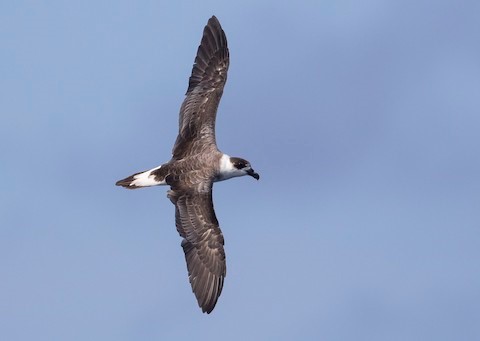
Black-capped Petrel, showing typically wide white rump. (Offshore from Cape Hatteras, North Carolina; August 24, 2019.) © Michael Todd

Bermuda Petrel, showing typically narrow white rump—also note dark “M” pattern. (Offshore from Bermuda; November 5, 2018.) © Derek Rogers

Black-capped Petrel, showing wide white rump contrasting with narrow black tail. (Offshore from Cape Hatteras, North Carolina; August 7, 2015.) © Jay McGowan

Bermuda Petrel, showing white rump narrower than gray tail—but note weak contrast between rump and tail. (Offshore from Bermuda; November 8, 2018.) © Peter Flood
Black-capped Petrel always has a broad white rump area that usually includes the upper tail feathers (in aberrant individuals even the entire tail can be white). The dark part of the tail is usually smaller than its white rump, sometimes about the same size, but never noticeably larger.
Bermuda Petrel typically has a narrow white rump band that rarely includes any of the tail. Its uppertail is sometimes pale gray, but not bright white. On Bermuda, the dark (or pale gray, in some cases) portion of its tail is always noticeably larger than the white rump band.
Collared vs. Cowled: Bermuda Petrel has a dusky “cowl” (partial hood), whereas Black-capped has a cap bordered by a paler collar—a pale nape and cheeks—and a narrow dark partial collar projecting down from the base of the neck.
Both species vary somewhat in the extent of these features, and some individuals become ambiguous due to feather-wear.
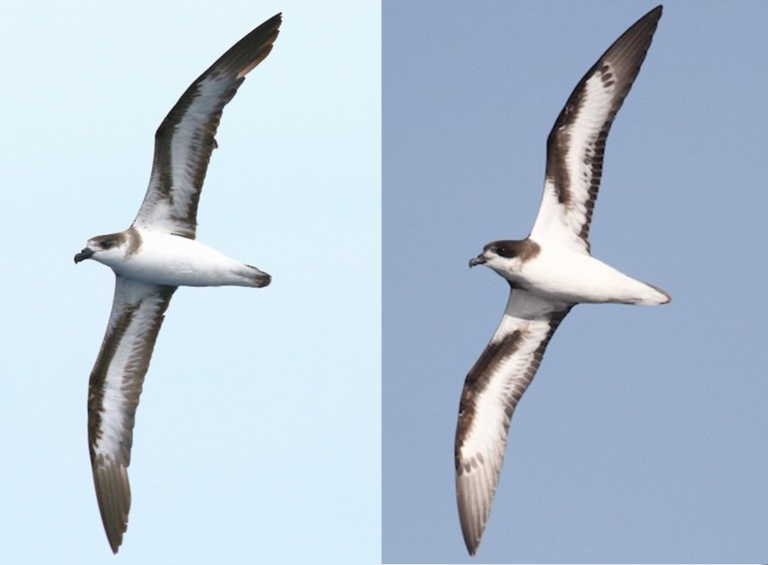
Black-capped Petrel (left, © Skip Russell) showing a pale nape and gray partial collar, compared to Bermuda Petrel’s cowl (right, © Peter Flood).
Exceptionally, in heavily worn plumage, some Bermuda Petrels develop a partially collared appearance that resembles Black-capped.
Also exceptionally, the darkest Black cappeds may have a dark nape and extensive partial collar, but not a cowl—which is diagnostic when present.
Underwing Pattern: At a glance, Black-capped and Bermuda Petrels seem to have the same basic underwing pattern: a white center bordered by a black carpal bar and black trailing edge. However, there are subtle but diagnostic differences, as Bermuda Petrel’s underwing has a distinctive “signature” pattern of two bars (one black, one white) that rarely, if ever, appears on Black-capped.
Black-capped varies in the proportions of white and black on the underwing. White-faced birds typically have an extensively white underwing framed by a thin black carpal bar and equally thin black trailing edge.
Dark-faced birds typically have a fairly thick carpal bar and a comparably thick black trailing edge, with an equal white strip in the middle—so the net impression is of three bars: black-white-black.
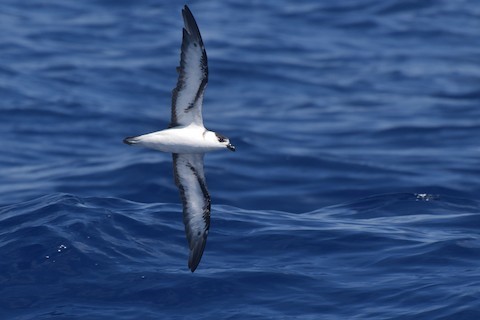
Black-capped Petrel, white-faced type, showing mostly white underwing with narrow black carpal bar and narrow black trailing edge. (Offshore from Cape Hatteras, North Carolina; June 5, 2016.) © Will Brooks
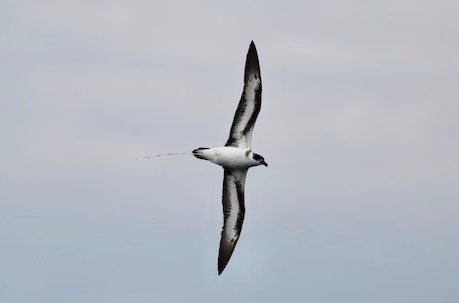
Black-capped Petrel, dark-faced type, showing underwing with broad black carpal bar and broad black trailing edge, with equal-width white area in the middle. (Offshore from Cape Hatteras, North Carolina; May 31, 2020.) © Jamie Adams
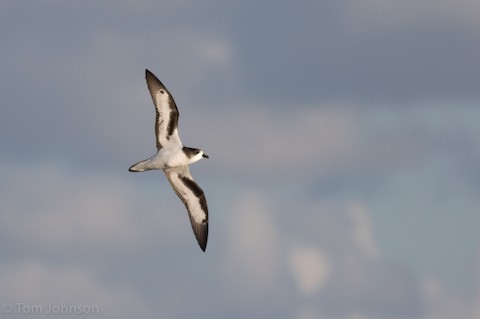
Bermuda Petrel, showing most distinctive version of “signature” underwing pattern: broad black carpal bar, broad white central bar, and narrow black trailing edge. (Offshore from Bermuda; November 18, 2016.) © Tom Johnson
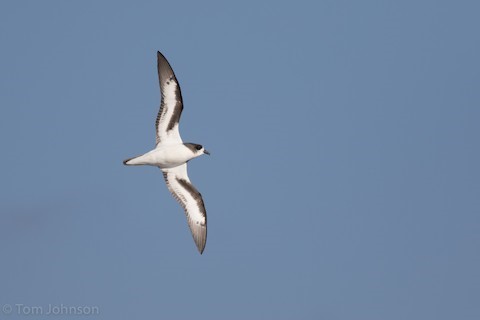
Bermuda Petrel, showing less distinctive version of “signature” underwing pattern: somewhat narrow black carpal bar, broad white central bar, and narrow black trailing edge. (Offshore from Bermuda; November 20, 2016.) © Tom Johnson
Bermuda’s underwing has a consistent pattern that differs from Black-capped’s. The black carpal bar is thick, covering about 30-40% of the width of the wing. In most cases (except briefly due to molt), the white area is equally thick or thicker, so the predominant pattern of its underwing is two contrasting bars—one black and the other white.
Capped vs. Masked: True to its name, Black-capped Petrel always has a dark cap, which is usually prominent, though the size of the dark area varies widely. Most Black-capped Petrels also have a pale nape, which accentuates the cap. A very small proportion of Black-capped Petrels lack the nape collar and can be mistaken for Bermuda Petrel.
On Bermuda Petrel’s head, when seen well in neutral lighting, the darkest feathering is usually around the eyes, whereas the top of its head is slightly paler, which gives it a masked (not capped) appearance. However, under normal field conditions this is often difficult to discern, and it is somewhat inconsistent: depending on molt stage and lighting, Bermuda can also appear dark-capped.
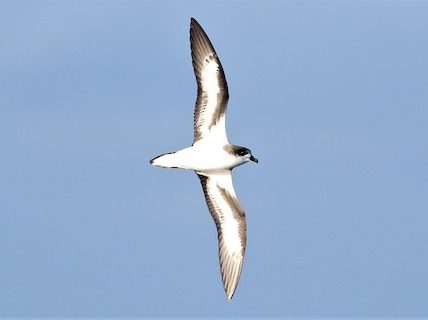
Bermuda Petrel in strong light, accentuating contrast between blackish mask and paler crown—also atypically pale underwing. (Offshore from Bermuda; November 10, 2018.) © Peter Flood

Bermuda Petrel, showing strong dark “M” pattern and white rump band narrower than dark tail. (Offshore from Bermuda; November 17, 2017.) © Peter Flood
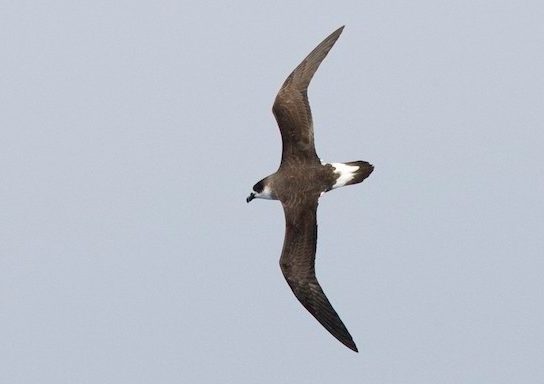
Black-capped Petrel, atypically lacking a white nape collar and showing a subtle “M”—but note bold white rump. (Offshore from Cape Hatteras, North Carolina; May 20, 2008.) © Brian Sullivan
Mantle: In both Bermuda and Black-capped, the overall coloration of the upperparts varies somewhat and changes with molt and feather-wear, as well as the persistent issue of variable lighting conditions. On average, Bermuda has paler upperparts, and it often and shows a pronounced “M” pattern. Black-capped sometimes shows an “M,” but it is subtle.
(Below are two photos of a Bermuda Petrel in worn plumage giving it a fairly strong resemblance to Black-capped Petrel.)
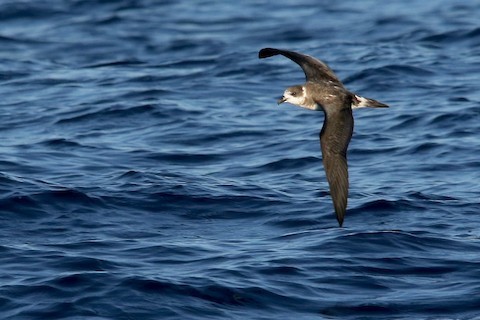
Bermuda Petrel, in worn plumage and showing features of Black-capped—white nape collar and dark-capped appearance—but note narrow white rump. (Offshore from Nantucket, Massachusetts; September 21, 2019.) © Benjamin Hack
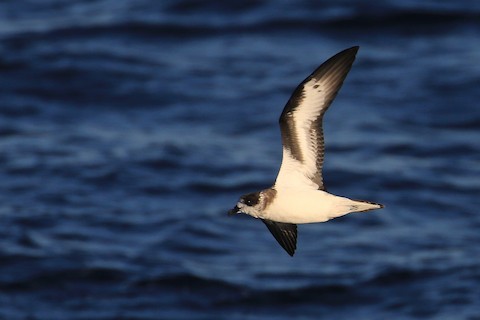
Bermuda Petrel, in worn plumage and showing features of Black-capped—white nape collar and dark-capped appearance—but note bold underwing pattern. (Offshore from Nantucket, Massachusetts; September 21, 2019.) © Tim Lenz
Notes
Monotypic species.
IUCN Red List Status: Endangered.
References
Alderfer, J., and J.L. Dunn. 2014. National Geographic Complete Birds of North America (Second Edition). National Geographic Society, Washington, D.C.
BirdLife International. 2018. Pterodroma cahow. The IUCN Red List of Threatened Species 2018: e.T22698088A132624115. https://dx.doi.org/10.2305/IUCN.UK.2018-2.RLTS.T22698088A132624115.en. (Accessed July 5, 2020.)
Brinkley, E.S., and K. Sutherland. 2017. Bermuda Petrel (Pterodroma cahow), version 1.0. In Neotropical Birds Online (T.S. Schulenberg, ed.). Cornell Lab of Ornithology, Ithaca, N.Y. https://doi.org/10.2173/nb.berpet.01.
eBird. 2020. eBird: An online database of bird distribution and abundance. Cornell Lab of Ornithology, Ithaca, N.Y. http://www.ebird.org. (Accessed July 5, 2020.)
Gehrman, E. 2012. Rare Birds: The Extraordinary Tale of the Bermuda Petrel and the Man Who Brought It Back from Extinction. Beacon Press, Boston.
Howell, S.N.G. 2012. Petrels, Albatrosses & Storm-Petrels of North America: A Photographic Guide. Princeton University Press, Princeton, N.J.
Howell, S.N.G., and K. Zufelt. 2019. Oceanic Birds of the World. Princeton University Press.
